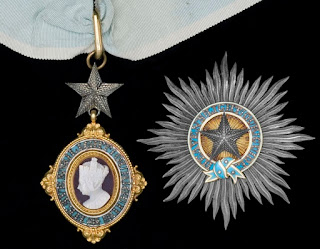| Lord Curzon, Viceroy of India, wearing the Grand Master's mantle, collar and star of the order |
The Most Exalted Order of the Star of India was the senior of the three orders of chivalry, now obsolescent, instituted to mark service to the British Raj in the Indian sub-continent.
 |
| Raja Sir Tanjore Madhava Rao, KCSI |
The Statutes might be similar to those of the Garter, the Thistle & the St Patrick. The number of its members to be few, perhaps 20 or 24 … The members to be invested by the Viceroy in person & thus do personal homage to him … The day for the investiture to be the anniversary of the Assumption of the Gov of India by the Crown of England.By the beginning of 1860 Prince Albert was drafting statutes, drawing up lists of possible members and working on the design of insignia. The Order was established in June 1861, with the first investitures held - in India and at Windsor - on 1 November 1861.
The Queen, being desirous of affording to the Princes, Chiefs and People of the Indian Empire, a public and signal testimony of Her regard, by the Institution of an Order of knighthood, whereby Her resolution to take upon Herself the Government of the Territories in India may be commemorated, and by which Her Majesty may be enabled to reward conspicuous merit and loyalty, has been graciously pleased, by Letters Patent under the Great Seal of the United Kingdom of Great Britain and Ireland, to institute, erect, constitute, and create, an Order of Knighthood, to be known by, and have for ever hereafter, the name, style, and designation, of 'The Most Exalted Order of the Star of India'
| Sir Umaid Singh Bahadur, GCSI, GCIE, KCVO, Maharaja of Jodhpur |
As structured in 1866, the order consisted of the sovereign, the Grand Master (the Viceroy and Governor-General of India), 36 GCSIs (18 British and 18 Indian), 85 KCSIs and 170 CSIs. GCSIs were drawn from ruling princes and the top tier of the British administration. KCSIs and CSI were included members of the Indian Civil Service and army who had given at least 30 years' service.
Women were eligible to be members of the order if they were the princely rulers - the Begum of Bhopal was a founder member in 1861. The statutes were specially amended to permit the admission of Queen Mary as a Knight Grand Commander in 1911.
The order lapsed in 1948, following the independence of India and Pakistan. The the last surviving member of the order, the Maharaja of Alwar, died in 2009.
Insignia
The insignia was exceptionally splendid. The last GCSI set, made in 1947, cost £3,500 to produce.
Knights Grand Commanders
| Sash, badge and star insignia of a GCSI |
A GCSI's insignia consisted of a gold collar and badge, a mantle of light blue satin with a representation of the star on the left and tied with a white silk cord with blue and silver tassles.
The badge was a central onyx cameo of a youthful Victoria set within an openwork and ornamental oval border of gold bearing the motto of the order ‘Heaven’s Light Our Guide’, surmounted by, and pendant from, a five-pointed star with large gold suspension loop, the whole badge being lavishly set with diamonds.
The breast star had a central five-pointed star of silver set with diamonds and set upon a gold and enameled ribbon bearing the motto of the order in silver and also set with diamonds,
Knights Commanders
 |
| Knight Commander's insignia |
These were similar to those of GCSIs, but smaller and less lavishly decorated.
Companions
 |
| Companion's breast badge |
No comments:
Post a Comment